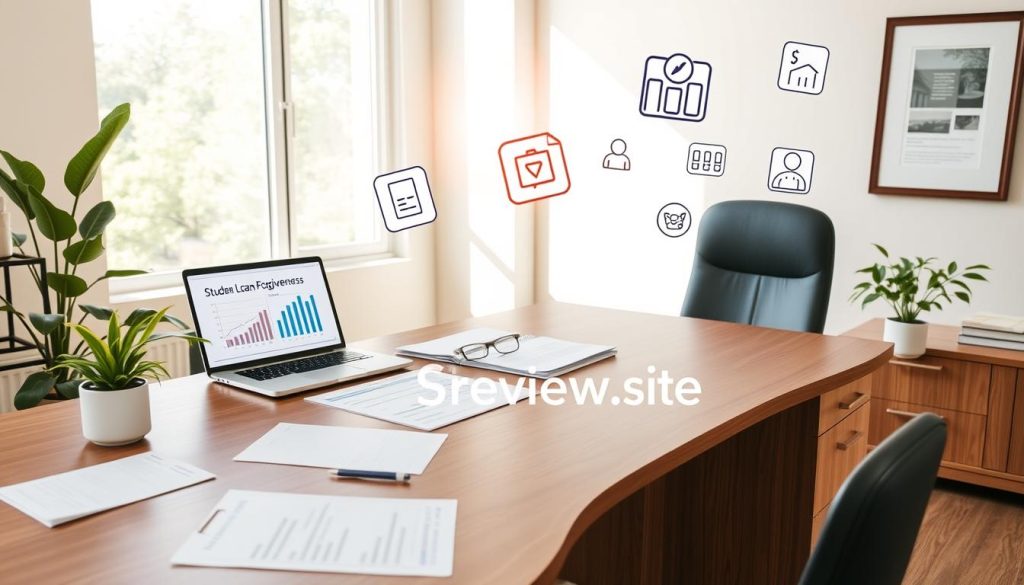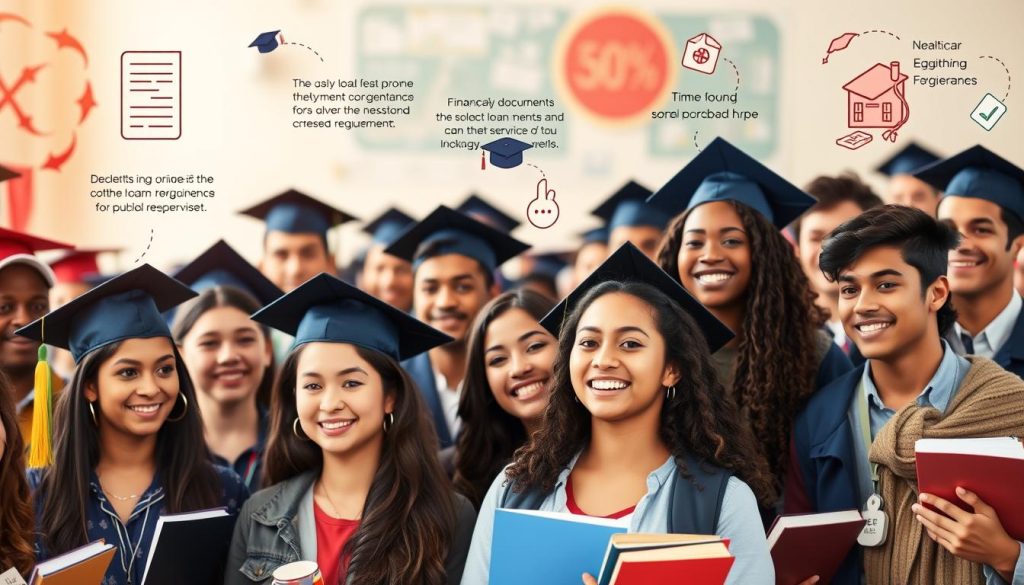Student loan forgiveness programs are a big help for those with student loan debt. It’s important to know who can apply and how to do it. Programs like the Public Service Loan Forgiveness (PSLF) can really help reduce or wipe out student loan debt.
As new rules come out from the Bureau of Federal Student Aid, it’s a good time to learn more. This information can help you understand if you qualify and how to apply for forgiveness.
Key Takeaways
- Student loan forgiveness programs help alleviate student loan debt.
- Understanding eligibility requirements is essential for successful applications.
- Public Service Loan Forgiveness (PSLF) is a prominent program available.
- The Bureau of Federal Student Aid is a key resource for updated information.
- Navigating the application process is critical for obtaining forgiveness.
Understanding Student Loan Forgiveness Programs
Student loan forgiveness programs help those struggling with educational debt. They aim to lessen or wipe out balances for those who qualify. There are many options, each suited for different situations and careers.
Income-driven repayment plans are a common choice. They adjust payments based on income, with forgiveness after a set time. Public Service Loan Forgiveness is for those in public service jobs. Both have specific rules to follow.
It’s key to know the differences between these programs. Some need longer service, while others focus on certain jobs. The Department of Education offers help to understand each option better.

Eligibility Requirements for Loan Forgiveness
Knowing the rules for loan forgiveness is key for those looking to ease their student loan burden. Different programs have their own rules for who can get forgiveness. These rules include who qualifies, how long you must work, and what kind of job you need.
Types of Eligible Borrowers
To get student loan forgiveness, you must fit into certain groups. These include:
- Full-time teachers in low-income schools
- Public service workers
- Employees of non-profit organizations
- Individuals serving in the military
These groups are chosen because they help the community a lot.
Minimum Service Duration
Forgiveness programs often have a time requirement. You usually need to make a set number of payments, from five to ten years. Meeting this requirement is essential for forgiveness.
Verified Employment Criteria
Showing you’re employed is a big part of the process. You’ll need to provide proof of your job history and current work status. This proof must come from your employer. It makes sure you meet the program’s rules.

Student Loan Forgiveness Programs: Eligibility and Application Process
Learning about student loan forgiveness programs can help borrowers make smart choices about their money. There are many programs for different jobs and situations. Each one has its own rules and steps to apply, making it easier to understand.
Overview of Available Programs
There are many student loan forgiveness programs out there. They mostly help those in public service and education. Here are some key ones:
- Public Service Loan Forgiveness (PSLF) – For government and non-profit workers.
- Teacher Loan Forgiveness – For teachers in low-income schools.
- Borrower Defense to Repayment – For those misled by their schools.
- State-Specific Initiatives – Many states have their own forgiveness plans, mainly for teachers and healthcare workers.
Comparison of Different Forgiveness Options
Each program has its own rules and benefits. Looking at the most popular ones helps see what makes them different. Here’s a table comparing some key programs:
| Program | Eligible Loans | Service Duration | Forgiveness Amount |
|---|---|---|---|
| Public Service Loan Forgiveness | Direct Loans | 10 years of qualifying payments | Remaining balance after 120 payments |
| Teacher Loan Forgiveness | Direct Loans, Subsidized/Unsubsidized Loans | 5 consecutive years of teaching | Up to $17,500 depending on subjects taught |
| Borrower Defense | Direct Loans | N/A | Varies based on claims |
Navigating the Application Process
Understanding the application process for student loan forgiveness can make things easier for eligible borrowers. A clear plan helps applicants move through each step smoothly. This ensures they are well-prepared and informed.
Step-by-Step Guide to Application
Starting your journey toward student loan forgiveness needs careful attention. Follow this guide to make your application process easier:
- Verify Eligibility: Check if you meet the requirements of your chosen forgiveness programs.
- Gather Necessary Information: Collect personal details like your Social Security number and income information.
- Prepare Documentation: Have all important documents ready, such as employment proof and loan statements.
- Complete Application Forms: Fill out the forgiveness program applications carefully, focusing on each section.
- Submit Your Application: Send your completed application and all documents to the right agency.
- Follow Up: Keep an eye on your application’s status and answer any additional information requests quickly.
Essential Documents Needed
Having the right documents ready is key for a successful application. Here’s a list of important documents for forgiveness program applications:
- Proof of Employment: Letters from employers confirming your work history.
- Loan Documentation: Current statements from your loan servicer showing your loan balance and repayment status.
- Income Statements: Recent pay stubs or tax returns to prove your income level.
- Identification: A government-issued ID to confirm your identity.
Federal Student Loans and Their Role in Forgiveness
It’s key to know about federal student loans if you’re looking into forgiveness programs. These loans have their own structure, benefits, and protections. They are different from private loans. Learning about them can help you on your financial path.
Understanding Federal Loans Basics
Federal student loans come in different types, each for different needs. The main types are:
- Direct Subsidized Loans: These are for those who need help, and the government covers the interest while you’re in school and during deferment.
- Direct Unsubsidized Loans: These are for everyone, and you pay the interest from the start.
- PLUS Loans: For graduate students and parents of undergrads. You need good credit, and the terms depend on your credit score.
- Consolidation Loans: You can merge several federal loans into one. This makes payments easier and might lower your interest rate.
How Federal Loans Differ from Private Loans
Federal loans have benefits that private loans don’t. The main differences are:
| Feature | Federal Student Loans | Private Loans |
|---|---|---|
| Interest Rates | Set by the government; usually lower and fixed | Varies by lender; can be fixed or variable |
| Repayment Plans | Flexible options, like income-driven repayment | Less flexible; may not offer income-driven plans |
| Borrower Protections | Options like deferment, forbearance, and forgiveness | Limited protections; may lack forgiveness options |
| Eligibility for Forgiveness | Eligible for federal forgiveness programs | Generally not eligible for federal forgiveness programs |
This comparison shows why federal loans are often better for forgiveness programs. Knowing these differences helps you make smarter financial choices. It can also save you money in the long run.
Income-Driven Repayment Plans and Loan Forgiveness
Borrowers find income-driven repayment plans very helpful. These plans adjust payments based on income and family size. This makes it easier to manage payments while working on other financial goals.
Plans like Revised Pay As You Earn (REPAYE), Pay As You Earn (PAYE), and Income-Based Repayment (IBR) offer flexible solutions. They are designed for different financial situations.
Overview of Income-Driven Plans
Income-driven repayment plans help those who can’t afford standard payments. They base payments on discretionary income. This is a big help for many borrowers.
These plans not only reduce financial stress but also lead to loan forgiveness. This is a big advantage for borrowers.
How Payments Affect Forgiveness Timeline
Knowing the loan forgiveness timeline is key for borrowers in these plans. Making payments on time helps reach forgiveness after 20 or 25 years. Payments are adjusted based on income and family size.
It’s important to keep submitting documents to loan servicers. This keeps borrowers eligible for forgiveness.
| Plan Name | Payment Percentage of Discretionary Income | Forgiveness Timeline |
|---|---|---|
| REPAYE | 10% | 20 years (undergrad) / 25 years (grad) |
| PAYE | 10% | 20 years |
| IBR | 15% | 20 years (new borrowers) / 25 years (existing borrowers) |
Conclusion
Understanding student loan forgiveness programs is key for those looking to ease their financial burden. Knowing who can apply, how to apply, and the role of federal loans is important. These details help borrowers manage their loans better.
Borrowers should do their homework and use available resources to learn about forgiveness options. The Federal Student Aid website is a great place to start. Also, getting help from financial aid offices can make the application process easier.
With the right knowledge and resources, borrowers can tackle the challenges of student loan forgiveness. This effort can lead to a more secure financial future. It’s a step towards a brighter future.
FAQ
What are student loan forgiveness programs?
Student loan forgiveness programs let eligible borrowers cancel part or all of their loans. These programs help those in public service or facing financial struggles.
Who qualifies for student loan forgiveness?
To qualify, you must work in certain fields like education or public service. You also need to make a set number of payments or show financial hardship.
How do I apply for student loan forgiveness?
First, check if you’re eligible. Then, collect the needed documents. Submit your application to the right loan servicer or program. Always follow the specific instructions for each program.
What is Public Service Loan Forgiveness (PSLF)?
PSLF forgives Direct Loans after 120 qualifying payments. You must work full-time for a qualifying employer, like a government or non-profit.
What are income-driven repayment plans, and how do they relate to loan forgiveness?
These plans adjust payments based on income and family size. Making consistent payments can lead to forgiveness after 20 or 25 years.
What documentation do I need to provide for forgiveness program applications?
You’ll need proof of employment, income statements, and loan details. Make sure all documents are accurate to avoid delays.
How does federal student loan forgiveness differ from private loan forgiveness?
Federal loans offer structured forgiveness options like PSLF. Private loans might not have these programs. Federal loans often have income-driven plans leading to forgiveness after many payments.
What is the timeline for loan forgiveness?
Forgiveness timelines vary. PSLF requires 120 payments, taking 10 years. Income-driven plans need 20 or 25 years of payments before forgiveness.
Where can I find more information about student loan forgiveness programs?
The U.S. Department of Education’s Federal Student Aid website is a great resource. It has detailed information on forgiveness programs and how to apply. Financial aid offices can also offer personalized advice.




